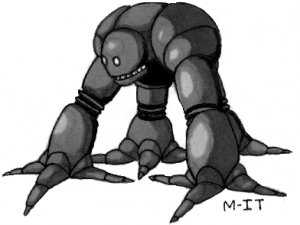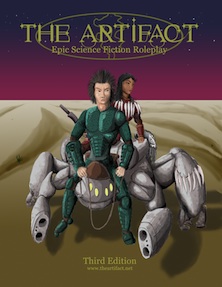Tarnoc was looking through the 3rd ed rough draft and turned his attention to the Scimrahn safehouse. We talked a bit about what they were and how to make them interesting. They are unabashedly the classic dungeon delve reskinned to fit in The Artifact. They are a series of tunnels filled with traps and mazes.
Tarnoc made a few lists of things that would be found in or near a safehouse, intended as a random generator for one. I knew it was a good idea to flesh this idea out for the players but it felt like it was missing something important. I realized that they should be built as a survival challenge rather than an ordinary set of random tables.
In other Survival Challenge posts, I’ve included basic ideas to make them more compatible for other games but I figure that this one is reasonably unique to The Artifact so I’ll leave it specific to the 3e rules. If you’re really sharp you’ll notice that I’ve gone from Surmount Points to Challenge Points (CP). This is to tie the points used in Tech Challenges in with the points in Survival Challenges. It made more sense to have a single term used in both instead of two separate solutions.
Scimrahn Safehouses
Scimrahn safehouses are fortified and camouflaged bunkers that Scimrahn run to when attacked and often store surplus they will not immediately need.
If a hex collapses, it often leaves natural voids in rubble that can form caves. This is a favorite location to carve out a Safehouse. These structures are designed to hide a tribe from the Chezbah and if discovered, give the tribe a strategic advantage in defending themselves.
Although officially any Scimrahn is supposed to be welcome to take shelter in a safehouse, this is not always followed by tribes that are storing their valuables. The fact that entire tribes are occasionally wiped out can leave these locations derelict and many Scimrahn seek out unused Safehouses either to use them for themselves or to loot them.
Surmount Method: Observing hidden hatches, symbols and noticing traps
Surmounting Attribute: Intuition
| Full | 1/2 | 1/4 | 1/8 |
| 1 | 2 | 3 | 4 |
10 CP for a new Safehouse (1-50 years)
20 CP for a older Safehouse (51-100 years)
40 CP for a very old Safehouse (101-300 years)
60 CP for an ancient Safehouse (301-800 years)
Hazards
Confusion
Just finding which crevice or chamber is the next stage of the safehouse is taxing. For every failed Intuition roll the characters face a confusion hazard. While moving through the safehouse the character has to search for small indications of traps or cues to travel further into the Safehouse. Failed Intuition rolls get 1 Mental stress point.
Random Hazard
For every survival round the GM should roll once on the following table.
Roll 1D100
| 1-25 | Hidden door |
| 26-40 | Maze |
| 41-60 | Hound trap |
| 61-70 | Pit trap |
| 71-80 | Demolished |
| 81-90 | Decoy entrance |
| 91-95 | AI Trap |
| 96-100 | Unique |
Hidden Door
A cleverly hidden door is used to make it harder find the next leg of the safehouse. Characters must make an Intuition roll with 2 50% Impairments to find the door. A character’s Scimrahn En skill may be used to add fractional successes to the roll. The player using the Scimrahn En skill should describe the symbols they found that leads them to the door.
Maze
A twisted knot work of crawlway passages with many leading to dead ends or looping back on themselves. Exploring the passages and finding the way out takes time and energy. Characters must make a Constitution roll or they take 2 Physical stress.
There is a 10% chance of a Chezbah hound in hibernation somewhere in the tunnels. It was sent in, got lost and shut down.
Hound Trap
These are traps meant to capture Chezbah Hounds. These often involve trapping a hound in a cramped tunnel between heavy doors (AR 50 200 HP) and then slowly crushing them in between the walls of the tunnel. The trap will wait for 30 seconds (3 turns) and then do 5d10 damage per turn for 5 turns. They are often well hidden and require an Intuition roll with 2 60% Impairments to see them before they’ve sprung. A character’s Scimrahn En skill may be used to add fractional successes to the roll. The player using the Scimrahn En skill should describe the symbols they found that warned them of the trap.
Only with a successful Scimrahn En skill roll can the trap be disabled for ten turns. The En are used to describe the solution to a combination lock that disables the trap.
To make the trap safer for a Scimrahn, there is almost always a release inside that requires a successful Dexterity check to disable the trap and release the occupant.
Pit Trap
These traps are used to catch Chezbah Warriors and Hounds. Since Hounds can jump very high, they often are very deep any one falling down one of these traps takes 3D10 points of damage from the fall. There is a 10% chance that there is a hibernating Chezbah Hound at the bottom of the pit. They are often well hidden and require an Intuition roll with 2 60% Impairments to see them before they’ve sprung. A character’s Scimrahn En skill may be used to add fractional successes to the roll. The player using the Scimrahn En skill should describe the symbols they found that warned them of the trap.
Demolished
The tunnel has been demolished either by a cave in or by Chezbah collapsing the tunnel intentionally.
Getting past the demolished tunnel requires that it be cleared of debris and braced up. This requires moving heavy boulders, dust and in some cases cutting through boulders too large to move.
This task has a value of 1D10 Challenge points by itself. The surmounting attribute is Strength. Each failed strength roll means the character takes 2 Physical stress. Tools like hammers, pry bars and rope give a 30% Advantage to the rolls.
Decoy Entrance
The passage being investigated is a decoy. the passage abruptly ends. Hidden Scimrahn En gives a clue as to the real passage’s whereabouts. The characters must double back out of the tunnel and look for the new passage.
AI Trap
Part of an E-suit, usually the upper torso with no shields or weapons, guards the passage. The E-suit torso is usually fixed in place and powered by hidden electrical cable. It blocks the passage unless the characters can give it a message written in En. If anyone gets near it without giving the key phrase, it will attack with it’s fists. The AI’s Agility and Reflex attributes are 1d6x10 but has a 40% Advantage to hit because of the small space in the passage. The E-Suit’s AR and BP are all standard but HP are usually around half their normal amount if only the torso is in place.
With a successful Scimrahn En skill roll the trap can be disabled for ten turns. The GM can describe the En that the characters find and if they have passed a skill give a string of ideas they represent. To guess at the pass phrase the characters will have to combine the ideas into a one to three word phrase. In most situations the AI will answer if it will allow the characters to pass. If the characters give the wrong key phrase they can ask if they can pass and the AI will answer no.
Unique
A unique and unusual system is used to confuse or kill Chezbah, The more dangerous the trap, the more En warnings there should be.
The GM should design their own trap. It should be decipherable by interpreting a string of 3 to 5 ideas given in En.
Defenses and Weaknesses
30% Chance Weakness: Scout
Many safehouses have a Scimrahn scout that lives in the area. This scout may know some or all of a newer safehouse. A scout that knows a safehouse may lead the characters to an inner Poord chamber that has supplies like old blankets, some water, old provisions and some fuel and complain that his tribe is poor. This chamber is accessible from the outside and is used to hide the tribes vehicles while they are hiding from Chezbah but there are often hidden cashes and inner chambers to hide women and children in. The PCs will have to explore on their own after this and the scout may be unhelpful or misleading.
For older safehouses, the scout may have explored some of it but it is unlikely they would have reached it’s inner chambers.
30% Chance Defense: Inner Poord
After 1D10 CP have been surmounted, the characters find a minor chamber with supplies like old blankets, some water, old provisions and some fuel. There should also be 2d6 Plasma Guns with clips, 4d6 Laser Guns with energy packs and 1d6 suits of armor patched together from suits that were damaged. This is to make the curious think they have found the inner Poord.
These chambers are in fact used by any tribe making use of the safehouse. The chamber is often large enough to house the tribes vehicles while they are hiding from Chezbah but there are often hidden cashes and inner chambers to hide women and children in.
Inner Poords are not accessed directly by the tunnels the characters will be crawling through. Usually there is a trigger deep inside a tunnel that when activated opens a large camouflaged door most often made of a very large boulder 3-5 meters in diameter.
The Roke
Roke is the Scimrahn word for home. This is the furthest inner chamber of the safehouse. It is where the children are sent when the safehouse is under siege and it is where the tribe keeps all it’s goods that cannot be easily carried.
Inside the Roke there is often a storehouse of 1d10 x ¥1,000,000 x the CP of the safehouse in Scimrahn, Kelrath and Chezbah goods.



 The Free RPG Blog
The Free RPG Blog